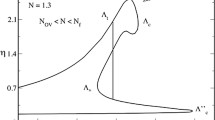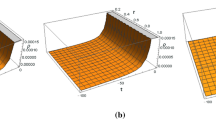Abstract
We examine the dynamics of a self-gravitating magnetized fermion gas at finite temperature near the collapsing singularity of a Bianchi-I spacetime. Considering a general set of appropriate and physically motivated initial conditions, we transform Einstein–Maxwell field equations into a complete and self-consistent dynamical system amenable for numerical work. The resulting numerical solutions reveal the gas collapsing into both, isotropic (“point-like”) and anisotropic (“cigar-like”), singularities, depending on the initial intensity of the magnetic field. We provide a thorough study of the near collapse behavior and interplay of all relevant state and kinematic variables: temperature, expansion scalar, shear scalar, magnetic field, magnetization, and energy density. A significant qualitative difference in the behavior of the gas emerges in the temperature range T/m f ∼10−6 and T/m f ∼10−3.






Similar content being viewed by others
Notes
Unless specified otherwise, we use natural units.
All thermodynamic quantities are time dependent through their dependencies on the magnetic field, the chemical potential and the temperature which are time-dependent variables.
As an example, considering the mass and charge of the electron yields the values b∼10−5⇒B∼108 G, ϕ∼10−3⇒T∼107 K and \(\tilde{\mu}=2\Rightarrow\mu\simeq 1~\hbox{MeV}\), which roughly correspond to the physical parameters of a white dwarf type astrophysical object.
References
S.L. Shapiro, S.A. Teukolsky, Black Holes, White Dwarfs, and Neutron Stars (Wiley, New York, 1983)
S. Chakrabarty, Phys. Rev. D 43, 627 (1991)
S. Chakrabarty, Phys. Rev. D 54, 1306 (1996). hep-ph/9603406
M. Chaichian, S.S. Masood, C. Montonen, A. Perez Martinez, H. Perez Rojas, Phys. Rev. Lett. 84, 5261 (2000). hep-ph/9911218
C.Y. Cardall, M. Prakash, J.M. Lattimer, Astrophys. J. 554, 322 (2001). astro-ph/0011148
R.G. Felipe, H.J. Mosquera Cuesta, A. Perez Martinez, H. Perez Rojas, Chin. J. Astron. Astrophys. 5, 399 (2005). astro-ph/0207150
A. Perez Martinez, H. Perez Rojas, H. Mosquera Cuesta, Int. J. Mod. Phys. D 17, 2107 (2008). arXiv:0711.0975 [astro-ph]
L. Paulucci, E.J. Ferrer, V. de la Incera, J.E. Horvath, Phys. Rev. D 83, 043009 (2011). arXiv:1010.3041 [astro-ph.HE]
A.P. Martínez, H.P. Rojas, H.J. Mosquera Cuesta, Eur. Phys. J. C 29, 111 (2003)
R.G. Felipe, A.P. Martinez, J. Phys. G 36, 075202 (2009). arXiv:0812.0337 [astro-ph]
E.J. Ferrer, V. de la Incera, J.P. Keith et al., Phys. Rev. C 82, 065802 (2010)
R.G. Felipe, D.M. Paret, A.P. Martinez, Eur. Phys. J. A 47, 1 (2011). arXiv:1003.3254 [astro-ph.HE]
A. Ulacia Rey, A. Perez Martinez, R.A. Sussman, Gen. Relativ. Gravit. 40, 1499 (2008). arXiv:0708.0593 [gr-qc]
A. Ulacia Rey, A. Perez Martinez, R.A. Sussman, Int. J. Mod. Phys. D 16, 481 (2007). gr-qc/0605054
D. Manreza Paret, A. Perez Martinez, A. Ulacia Rey, R.A. Sussman, J. Cosmol. Astropart. Phys. 1003, 017 (2010). arXiv:0812.2508 [gr-qc]
H.Y. Chiu, V. Canuto, L. Fassio-Canuto, Phys. Rev. 176, 1438 (1968)
V. Canuto, H.Y. Chiu, Phys. Rev. 173, 1229 (1968)
V. Canuto, H.Y. Chiu, Phys. Rev. 173, 1220 (1968)
V. Canuto, H.Y. Chiu, Phys. Rev. 173, 1210 (1968)
J. Schwinger, Phys. Rev. 82, 664 (1951)
C.W. Misner, K.S. Thorne, J.A. Wheeler, Gravitation (Freeman, New York, 1998)
J. Wainwright, G.F.R. Ellis, Dynamical System in Cosmology (Cambridge University Press, Cambridge, 1997)
D. Ebert, K.G. Klimenko, M.A. Vdovichenko, A.S. Vshivtsev, Phys. Rev. D 61, 025005 (2000). hep-ph/9905253
D. Ebert, K.G. Klimenko, Nucl. Phys. A 728, 203 (2003). hep-ph/0305149
J.O. Andersen. hep-ph/9709331
C.O. Dib, O. Espinosa, Nucl. Phys. B 612, 492 (2001)
A. Ayala, A. Sanchez, G. Piccinelli, S. Sahu, Phys. Rev. D 71, 023004 (2005). hep-ph/0412135
Acknowledgements
The work of A.P.M, A.U.R and I.D.G has been supported by Ministerio de Ciencia, Tecnología y Medio Ambiente under the grant CB0407 and the ICTP Office of External Activities through NET-35. A.P.M. acknowledges the hospitality of ICN-UNAM and the financial support of ICyTDF-CLAF fellowship programme. R.A.S. and A.U.R. acknowledge support from the research grant SEP–CONACYT–132132, and the TWAS-CONACYT fellowships.
Author information
Authors and Affiliations
Corresponding author
Appendix A: Contributions to EOS
Appendix A: Contributions to EOS
The thermodynamical potential of a fermion gas has two contributions, see Eq. (9), and thus we can express the magnetization as \(M_{f}=M_{f}^{\mathrm{SQFT}}+M_{f}^{\mathrm{QFT}}\). Taking it into account we can rewrite the EOS (42)–(47) in the following form:
where we identify by \(\overline{P}_{\|}\), \(\overline{P}_{\bot}\) and \(\overline{U}\) the terms corresponding to our approximate EOS, while ΔP ∥, ΔP ⊥, and ΔU represent those that have been neglected. Note that these last terms are only field dependent.
In order to analyze the contribution of ΔP ∥, ΔP ⊥, and ΔU to its respective EOS, we evaluate the expressions \(\Delta P_{\|} / \overline{P}_{\|}\), \(\Delta P_{\bot} / \overline{P}_{\bot}\), and \(\Delta U / \overline{U}\) in the sets of solutions obtained previously. In all the cases the numerical results show that these terms are not significant for values of magnetic field less than or equal to the critical magnetic field.
To exemplify that mentioned above, in Fig. 7 we show the fractions of the EOS neglected during the evolution of the gas starting from ϕ(0)=10−3, b(0)=5×10−5, \(\tilde{\mu}(0)=2\), S 2(0)=0, and S 3(0)=1. As we can observe these values remain close to zero for B≲B c , specifically \(\Delta P_{\|} / \overline {P}_{\|}\), \(\Delta P_{\bot} / \overline{P}_{\bot}\), and \(\Delta U / \overline{U}\) remain below the line fraction=0.135. The graph of magnetic field is included for comparison.
Rights and permissions
About this article
Cite this article
Delgado Gaspar, I., Pérez Martínez, A., Sussman, R.A. et al. Gravitational collapse of a magnetized fermion gas with finite temperature. Eur. Phys. J. C 73, 2502 (2013). https://doi.org/10.1140/epjc/s10052-013-2502-y
Received:
Revised:
Published:
DOI: https://doi.org/10.1140/epjc/s10052-013-2502-y





